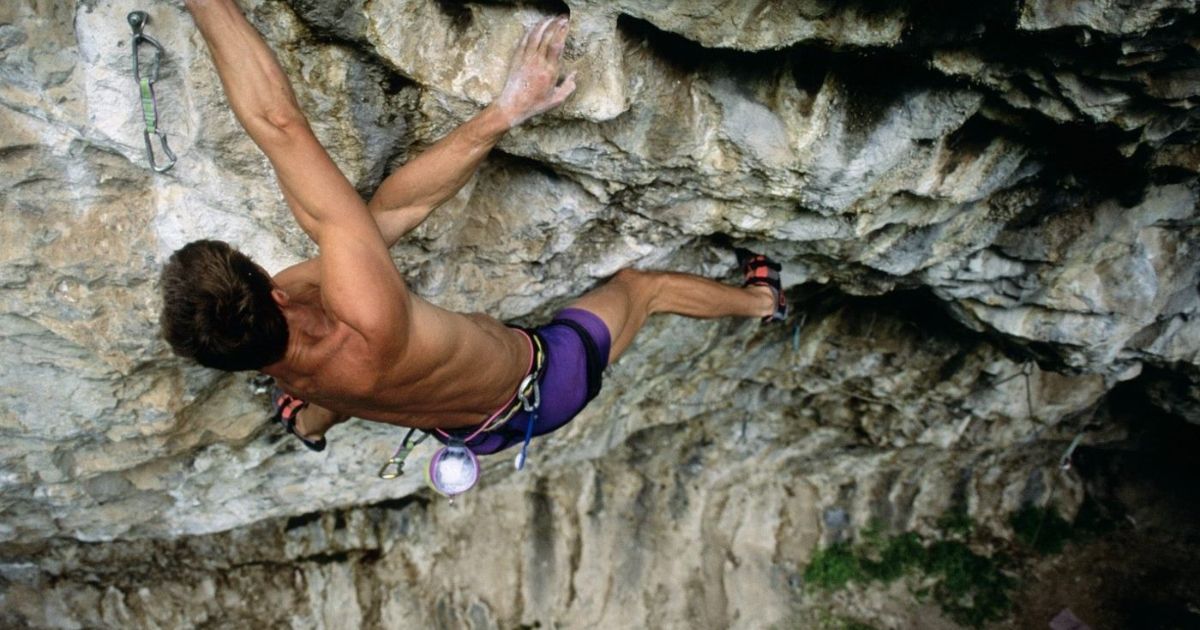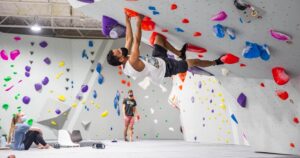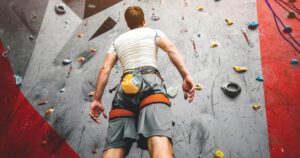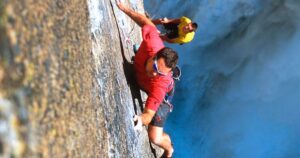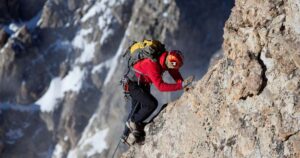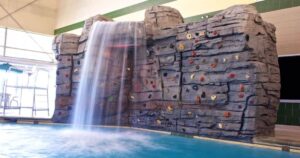Rock climbing and calisthenics: two physical activities that may seem worlds apart. However, upon closer examination, these seemingly distinct pursuits share surprising similarities. This article explores the question: is rock climbing calisthenics? By analyzing the benefits, muscle groups targeted, and training techniques involved in both activities, we can determine if rock climbing can be considered a form of calisthenics. Through a scientific and evidence-based approach, this article aims to shed light on the relationship between these two popular forms of exercise.
Key Takeaways
- Rock climbing and calisthenics both focus on bodyweight movements and strength training.
- Both activities target multiple muscle groups simultaneously and improve strength, endurance, flexibility, and coordination.
- Rock climbing requires specialized gear and takes place on natural or artificial rock formations, while calisthenics can be performed with minimal equipment or just bodyweight in various settings.
- While rock climbing requires grip strength and core stability, calisthenics targets overall strength and flexibility.
Benefits of Rock Climbing as Exercise
The benefits of rock climbing as exercise are numerous and can greatly enhance one’s physical fitness and strength. Beyond the obvious physical benefits, rock climbing also offers significant mental benefits. Engaging in this challenging activity requires focus, problem-solving skills, and mental resilience. The intense concentration required while climbing can help improve cognitive function, memory, and concentration skills. Additionally, the thrill and sense of accomplishment that comes with reaching the top of a difficult climb can boost self-confidence and overall mental well-being.
Rock climbing also provides an excellent opportunity to improve flexibility and cardiovascular fitness. Climbers often need to contort their bodies into various positions to navigate through different routes and holds, which enhances flexibility and range of motion in the muscles and joints. Additionally, the physical demands of rock climbing can elevate your heart rate and engage your cardiovascular system, making it an effective form of Rock Climbing Cardio exercise. Over time, regular rock climbing training can lead to improved overall flexibility and enhanced cardiovascular endurance, making it easier to perform daily activities and reducing the risk of injuries.
Transitioning to the subsequent section about the similarities between rock climbing and calisthenics, it is important to note that both forms of exercise focus on improving physical fitness through bodyweight movements and strength training.
Similarities Between Rock Climbing and Calisthenics
Rock climbing and calisthenics share commonalities in their focus on bodyweight movements and strength training. Both activities utilize the individual’s own body weight as resistance to build strength and improve overall fitness. Rock climbing techniques involve using the arms, legs, and core muscles to navigate various routes and overcome obstacles. Similarly, calisthenics exercises such as push-ups, pull-ups, and squats also rely on bodyweight movements to target multiple muscle groups simultaneously. To further illustrate these similarities, consider the following table:
| Rock Climbing Techniques | Calisthenics Exercises |
|---|---|
| Bouldering | Push-ups |
| Rope Climbing | Pull-ups |
| Dynos | Squats |
| Campus Board Training | Planks |
In both rock climbing and calisthenics, individuals develop strength, endurance, flexibility, and coordination through consistent practice. These activities offer a challenging and rewarding form of exercise that promotes functional fitness and a sense of accomplishment.
Differences Between Rock Climbing and Calisthenics
While rock climbing and calisthenics may share similarities in their focus on bodyweight movements and strength training, there are distinct differences between the two activities.
- Equipment: Rock climbing requires specialized gear such as ropes, harnesses, and climbing shoes, while calisthenics can be performed with minimal equipment or even just body weight.
- Environment: Rock climbing takes place on natural or artificial rock formations, requiring climbers to navigate different terrains and heights. On the other hand, calisthenics can be performed in various settings, such as a gym, park, or even at home.
- Training techniques: Rock climbing involves specific techniques, such as belaying, rappelling, and using climbing holds, to ascend the wall. Calisthenics, on the other hand, focuses on bodyweight exercises like push-ups, pull-ups, and squats to build strength and flexibility.
Understanding these differences can help individuals choose the activity that aligns with their preferences and goals in terms of training techniques and overall experience.
Muscle Groups Targeted in Rock Climbing
In terms of muscle engagement, rock climbing requires the activation of various muscle groups throughout the body. Grip strength plays a crucial role in rock climbing as it allows climbers to maintain a firm hold on the rock surface. Additionally, core muscles are heavily utilized in rock climbing to provide stability and control during movements. Let’s take a closer look at the specific muscle groups targeted in rock climbing:
| Muscle Group | Function |
|---|---|
| Forearms | Responsible for grip strength and forearm endurance |
| Biceps | Aid in pulling movements and maintaining upper body strength |
| Shoulders | Provide stability and control during climbing |
| Back | Support the upper body and assist in pulling movements |
| Core | Essential for maintaining balance and stability |
Developing strength in these muscle groups is crucial for improving performance and preventing injuries in rock climbing. Therefore, incorporating exercises that target these areas can greatly enhance climbing abilities.
Incorporating Calisthenics Into Rock Climbing Training
To enhance rock climbing performance and prevent injuries, it is essential to integrate calisthenics exercises into training routines. Calisthenics, a form of exercise that uses body weight as resistance, offers numerous benefits for overall fitness and can be easily incorporated into other sports, including rock climbing. Here are three key ways to integrate calisthenics into rock climbing training:
- Bodyweight exercises: Incorporate exercises such as push-ups, pull-ups, and squats to build strength in the upper body, core, and lower body. These exercises target the same muscle groups used in rock climbing, helping climbers develop the necessary strength and endurance.
- Balance and flexibility exercises: Calisthenics exercises like yoga and Pilates can improve balance and flexibility, which are crucial for rock climbers to maintain stability and maneuver through challenging routes.
- High-intensity interval training (HIIT): Including HIIT workouts in your training routine can enhance cardiovascular fitness and improve endurance, allowing climbers to sustain longer climbs and recover faster between routes.
Frequently Asked Questions
What Equipment Is Needed for Rock Climbing?
Rock climbing requires specific gear to ensure safety and success. Essential equipment includes a helmet, harness, climbing shoes, ropes, carabiners, and a belay device. A thorough climbing equipment checklist is necessary for a successful rock climbing experience.
How Does Rock Climbing Improve Mental Fitness?
Rock climbing improves mental fitness by enhancing focus and reducing stress. It requires problem-solving skills, concentration, and strategic thinking, all of which contribute to cognitive development and resilience.
Can Rock Climbing Be Dangerous?
Rock climbing can be dangerous without proper safety measures. Beginners should undergo training programs to learn techniques and safety protocols. Despite the risks, with the right precautions, rock climbing can be a rewarding and exhilarating activity.
Is Rock Climbing Suitable for Beginners?
Rock climbing is a suitable activity for beginners as it allows for the development of rock climbing techniques and skills over time. It is advised to start at beginner-friendly locations that offer manageable routes and appropriate safety measures.
What Are Some Common Injuries Associated With Rock Climbing?
Common rock climbing injuries include sprains, strains, fractures, and tendonitis. To prevent these injuries, climbers should engage in proper warm-up exercises, use appropriate equipment, maintain good technique, and gradually increase difficulty levels.
Conclusion
In conclusion, rock climbing can be considered a form of calisthenics due to the similar muscle groups targeted and the physical benefits it provides. Both activities require strength, endurance, and flexibility, making them effective forms of exercise. However, there are also notable differences between rock climbing and traditional calisthenics exercises. While calisthenics focus on bodyweight movements, rock climbing incorporates the use of equipment and technique. Overall, rock climbing offers a unique and challenging workout that engages multiple muscle groups and promotes physical fitness.


